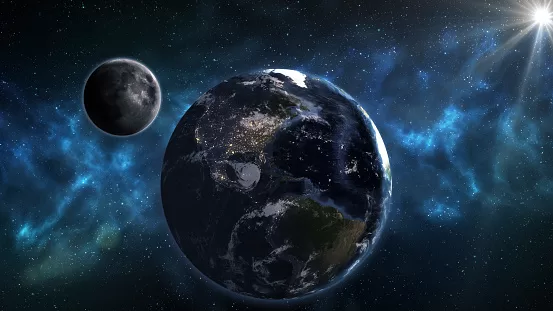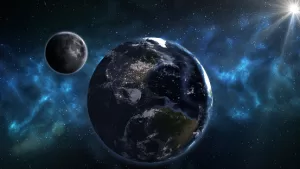
Blue Earth and moon in the space. Space wallpaper. Elements of this image furnished by NASA. Night Earth, Earth map and clouds map from: http://visibleearth.nasa.gov Moon from: https://astrogeology.usgs.gov/search/map/Moon/Clementine/UVVIS/Lunar_Clementine_UVVIS_750nm_Global_Mosaic_118m_v2 3D render from Adobe After Effects.
Earth to Capture a New Mini-Moon on September 29, 2024: What You Need to Know
By Jamie Carter, Senior Contributor at Forbes
In a remarkable astronomical event, Earth is set to gain a temporary “second moon” on September 29, 2024, in the form of asteroid 2024 PT5. This mini-moon, while only staying for a couple of months, is a fascinating glimpse into the dynamic interactions between Earth and near-Earth objects (NEOs). Here’s everything you need to know about Earth’s newest companion, 2024 PT5.
What is 2024 PT5?
2024 PT5 is a near-Earth asteroid (NEA) with a diameter of 11 meters, roughly the size of two giraffes. Discovered on August 7, 2024, by South Africa’s Asteroid Terrestrial-impact Last Alert System (ATLAS) telescope, this Arjuna asteroid hails from a group of asteroids known for their Earth-like orbits around the sun.
What makes 2024 PT5 special is that it will be captured by Earth’s gravitational field, placing it into orbit around our planet for a short period. Starting September 29, 2024, this mini-moon will orbit Earth until November 25, 2024, after which it will break free and continue its journey around the sun.
Where Did 2024 PT5 Come From?
Asteroids like 2024 PT5 are believed to originate from the Main Asteroid Belt, located between the orbits of Mars and Jupiter. More specifically, PT5 belongs to the Arjuna family of asteroids, which share a path similar to Earth’s orbit. These asteroids have relatively low velocities, allowing them to be temporarily captured by Earth’s gravity, creating what scientists refer to as a “temporarily captured flyby.”
Where Is 2024 PT5 Now?
Currently, 2024 PT5 resides in the northern sky, within the constellation Draco. Despite being approximately 1.9 million miles from Earth, it’s far too faint to be seen with the naked eye, or even with most backyard telescopes. With a magnitude of 22, only astronomers using large, professional telescopes will be able to observe it.
Earth’s Other Moons and Mini-Moons
While Earth only has one true moon, it occasionally captures smaller asteroids like 2024 PT5, pulling them into temporary orbits. These objects, termed mini-moons, eventually escape and continue their journey around the sun. Earth also has “quasi-satellites” like Kamo’oalewa, an asteroid that appears to orbit Earth but is actually orbiting the sun in near-perfect sync with our planet.
Kamo’oalewa, discovered in 2016, is considerably larger than 2024 PT5, measuring between 40 to 100 meters across, about the size of the Statue of Liberty. Though these objects are not true moons, they highlight the fascinating gravitational interactions Earth has with smaller objects in space.
What Happens Next?
2024 PT5’s time as Earth’s mini-moon will end on November 25, 2024, as it escapes our planet’s gravity and returns to its orbit around the sun. However, it will return near Earth again on January 9, 2025, for another close encounter.
While this asteroid’s brief visit won’t be visible to most of us, the study of such near-Earth objects is crucial for understanding the dynamics of space and Earth’s role in capturing these temporary satellites. Events like these remind us that our planet is part of an active and evolving cosmic environment.
Wishing You Clear Skies
Stay curious about the night sky, as there’s always something exciting to discover—whether it’s a mini-moon like 2024 PT5 or a new comet on the horizon. Although this particular mini-moon won’t be visible, it’s a reminder of the endless wonders of space.
Jamie Carter is an award-winning reporter and experienced stargazer who covers the night sky. Follow him on Twitter or LinkedIn for more updates on astronomy and upcoming celestial events.
Is this conversation helpful so far?
Will it hit Earth?
How






